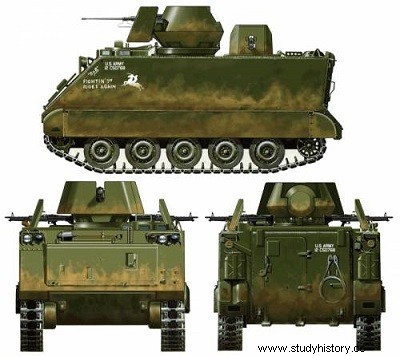
M113, M113A1, M106, M132, M163 and variants
Type: troop carrier vehicle.
Crew :2 men + 11 fighters.
Armament :a Browning .50 machine gun (12.7 mm).
Armor:
minimum 12mm;
maximum 38mm.
Dimensions:
length: 4.863 m;
width: 2.686m;
height: 2.5 m.
Weight in combat order: 11.15 t
Ground pressure: 0.55 kg/cm2.
Engine: General Motors Model 6V53 6 cyl. water-cooled diesel, developing 215 hp at 2,800 rpm.
Performance:
road speed: 67.6 km/h;
speed on water speed:5.8 km/h;
range :483 km;
vertical obstacle :0.61 m;
clean cut :1.68 m;
slope :60%.
Service time: introduced in 1960 in the US Army. Also used by Germany, Argentina, Australia, Bolivia, Brazil, Cambodia, Canada, Chile, South Korea, Denmark, Ecuador, Spain, Ethiopia, Guatemala, Greece, Haiti, Iran, Israel, Italy, Laos, Lebanon, Libya, New Zealand, Norway, Pakistan, Netherlands, Peru, Philippines, Somalia, Switzerland, Thailand, Turkey, Uruguay and Vietnam.
In the early 1950s, the US Army's standard APC was the M75, followed by the M59 in 1954. Neither was satisfactory, and in 1954 a new series of APCs was started. vehicles.
In 1958, two prototypes were completed, the T113 (aluminum hull) and the T11 7 (steel hull). A modified version of the T113, the T/ /3E1, received official approval in mid-1959 and production began in 1960 at the FMC plant in San Jose, California. The vehicle is still manufactured, the total production to date exceeding 60,000 units The machine is also built in Italy by the company Oto Melara which released 4,000 other examples for the Italian army and for export.
In 1964, the M113 was replaced by the M113A1, identical to its predecessor but equipped with a diesel engine rather than a gasoline engine. The M113A 1 finds another advantage in its increased range. This machine has the honor of being the first combat vehicle with aluminum armor.
The driver is seated at the front left of the hull. the engine is on its right. The captain's hatch is located in the center of the roof and the troop compartment at the rear of the hull. A large ramp at the rear of the hull provides an entry and exit route for infantrymen who can also use a hatch in the roof of their compartment. The base vehicle is normally armed with a pintle-mounted .50 Browning, loaded with 2,000 rounds
The M113 is fully amphibious, propelled through water by its tracks. IR headlights are standard equipment. The FMC has developed a whole range of kits improving the tactical possibilities of the vehicle:a sanitary kit. an NBC protection kit, a heating kit, a field work kit for mounting a bulldozer blade, various models of shields for the machine gun. etc.
The variants forming the family of the M113 are today more numerous than for any other combat machine and the space allotted to us obliges us to mention only some of the most important models.
The M577 is the PC model, with a raised roof, without armament. autobr' /> The flamethrower model, designated M132A1, is used only in the US Army.
The recovery model, M806A1, mounts a winch and spades at the rear stabilization.
The anti-aircraft model bears the name of Vulcan Air Defense System or M163; its armament consists of a sixfold piece of 20 mm General Electric.
The M548 tracked tanker, derived from the M113 chassis, can carry five tons of cargo and is probably amphibious.
This machine has many variants, including the M727, which carries three “Hawk” surface-to-air missiles, and the M730, armed with four “Chaparral” short-range surface-to-air missiles.
Yet another version, the M752, mounts the "Lance" tactical missile system, while the M688 carries two reserve projectiles.
The British Aircraft Corporation has just developed a model equipped with eight SAM Rapiers” in the firing position and this device is now in production for the Iranian army.
Many countries have adapted the basic M113 to their specific needs. For example, Australia gave him either the turret of the British Saladin armored car or the turret of the American Cadillac Commando armored car; even today, we are testing an M113 equipped with the turret of the British CVR(T) Scorpion. The Germans and the Dutch modified the vehicle to add the British "Green Archer" radar mortar location system.
The Bundeswehr did not adopt the standard US Army M113 mortar carrier, but fitted many of these vehicles with the 120 mm Tampella mortar.
The West Germans also have of several vehicles providing fire control. The US Army also uses the M113 to tow the "Tow" anti-tank guided vehicle system.
The FMC further perfected the M113 to make it the MICV now in production for the Dutch army. This machine mounts a 25 mm cannon and a 7.62 mm coaxial under the turret and has firing hatches in the side and rear walls of the hull. The Lynx Reconnaissance Vehicle, or M113 1/2, uses many components of the M113 APC; this model is used by Canada and the Netherlands.
